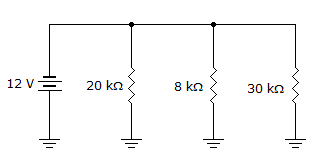Discussion
Home ‣ Electronics ‣ Parallel Circuits See What Others Are Saying!
- Question
If two equal resistors are connected in parallel, they will carry identical currents.
Options- A. True
- B. False
- Correct Answer
- True
- 1. An input to the mode pin of an arithmetic-logic unit (ALU) determines if the function will be _________.
Options- A. one's complemented
- B. positive or negative
- C. with or without carry
- D. arithmetic or logic Discuss
- 2. The output of a NAND gate is the same as the inverted output of an AND gate.
Options- A. True
- B. False Discuss
- 3. How many basic binary subtraction combinations are possible?
Options- A. 4
- B. 3
- C. 2
- D. 1 Discuss
- 4. What causes the piezoelectric effect?
Options- A. heat or dissimilar metals
- B. pressure on a crystal
- C. water running on iron
- D. a magnetic field Discuss
- 5. 64 hexadecimal equals 100 decimal.
Options- A. True
- B. False Discuss
- 6. The negative and positive charge symbols are assigned (in that order) to the:
Options- A. proton and electron
- B. electron and proton
- C. atom and nucleus
- D. electron and element Discuss
- 7. Above the critical frequency (fc) of a low-pass filter, the output voltage gain _______.
Options- A. does not change
- B. doubles for every 1 kHz increase in frequency
- C. increases
- D. decreases Discuss
- 8.

The total power in the given circuit is ___.
Options- A. 4.8 mW
- B. 18 mW
- C. 7.2 mW
- D. 30 mW Discuss
- 9. Inductance is proportional to the cross-sectional area of a coil.
Options- A. True
- B. False Discuss
- 10. End around carry is an operation in 1's complement subtraction where a 1 is added to the sum of the 1's complement of both numbers.
Options- A. True
- B. False Discuss
More questions
Correct Answer: arithmetic or logic
Correct Answer: True
Correct Answer: 4
Correct Answer: pressure on a crystal
Correct Answer: True
Correct Answer: electron and proton
Correct Answer: decreases
Correct Answer: 30 mW
Correct Answer: True
Correct Answer: False
Comments
There are no comments.More in Electronics:
Programming
Copyright ©CuriousTab. All rights reserved.
